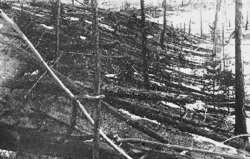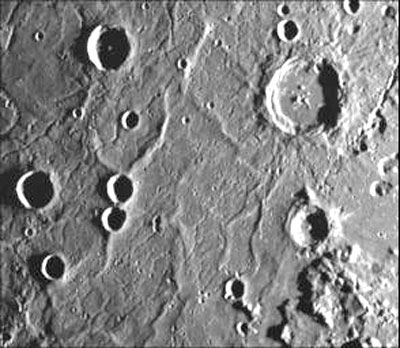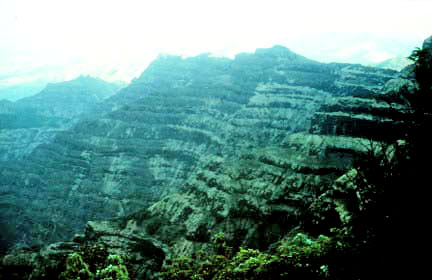|

by Michael Paine
05 November 1999
from
Space Website
Imagine: NASA scientists announce they
have detected a 10-mile-wide asteroid on a collision course with the
Earth. They calculate it will hit Southeast Asia in two weeks. There
is no chance of Bruce Willis being sent on a beefed-up space shuttle
to blow up the asteroid.
Earthlings will have to ride out the
impact.

The Tunguska event in 1908
flattened 800 square miles of Siberian forest
-- and the object
didn't even reach the ground.
The world economy grinds to a halt as
people take to the hills.
Anarchy sets in, civilization breaks down.
Accusations fly over the lack of warning -- where was Spaceguard,
the proposed international search effort for large asteroids?
People in Brazil feel less vulnerable than most of the world's
population. They are on the opposite side of the Earth from the
predicted impact point. But one hour after the impact Brazilians
notice some brilliant meteors. Then more meteors. Soon the sky gets
brighter and hotter from the overwhelming number of meteors. Within
a few minutes trees ignite from the fierce radiant heat. Millions of
fragments of rock, ejected into space by the blast, are making a
fiery return all over the planet.
Only people hiding underground survive the deadly fireworks display.
Within three hours, however, massive shock waves from the impact
travel through the Earth's crust and converge on Brazil at the same
time. The ground shakes so violently that the ground fractures and
molten rock spews from deep underground. Maybe Brazil wasn't the
best place to be after all.
The survivors of the firestorms, tsunami and massive earthquakes
emerge to a devastated landscape. Within a few days the Sun vanishes
behind a dark thick cloud - a combination of soot from the
firestorms, dust thrown up by the impact and a toxic smog from
chemical reactions. Photosynthesis in plants and algae ceases and
temperatures plummet. A long, sunless Arctic winter seems mild
compared to the new conditions on most of the planet.
After a year or so the dust settles and sunlight begins to filter
through the clouds. The Earth's surface starts warming up. But the
elevated carbon dioxide levels created by the fires (and, by chance,
vaporization of huge quantities of limestone at the impact site)
results in a runway greenhouse effect. Those creatures that managed
to survive the deep freeze now have to cope with being cooked.
Many species of plants and animals vanish. The few hundred thousand
human survivors find themselves reverting to a Stone Age existence.
Is it fiction?
Computer modeling of asteroid impacts and climatic effects suggest
that this devastating sequence of events could happen.
Fortunately
it is extremely unlikely that this scenario will occur in our time.
No known asteroids are on a collision course with Earth. However,
every 50 to 100 million years the Earth collides with a comet or
asteroid of sufficient size to cause planet-wide devastation.
Evidence of past impacts has only been recognized in recent decades
and is pointing to the conclusion that big impacts have caused major
disruptions to the development of life on Earth.

Known impact craters.
IMAGE: Canadian Geological Survey
The end of the dinosaurs
(click image to
enlarge)
In 1980 Scientists Luis and Walter
Alvarez claimed they had found evidence of a huge impact event 65
million years ago. This age corresponded with the demise of the
dinosaurs at the end of the Cretaceous Period. The evidence included
a worldwide layer of clay with high levels of the rare element
iridium, usually the signature of an impact.
The search was on for a giant crater associated with this impact.
Hopes weren't high because in 65 million years the Earth's surface
has changed dramatically -- nearly all of the present ocean floor is
younger than 50 million years.
Some great scientific detective work pointed to an impact somewhere
in Central or North America. Finally, in 1990, the buried remains of
a 150-mile-diameter crater were discovered near the town of
Chicxulub on the Yucatan Peninsula in Mexico. A crater this size
would have been blasted out by a 10-mile-wide comet or asteroid
colliding with the Earth at some 50,000 mph.
The "smoking gun" had
been found.
Impact,
volcanoes, or both?
The debate continues on whether the Chicxulub impact caused the mass
extinction at the end of the Cretaceous Period or whether it was one
of a sequence of disasters.
The Deccan Traps of India are the
remnants of a massive upwelling of molten rock from deep within the
Earth 65 million years ago. The toxic fumes and dust from the
eruption have been put forward as a possible alternative cause of
climate change that led to the extinction of the dinosaurs.
A possible link between impacts and volcanism became evident in 1974
when the Mariner 10 spacecraft flew past the innermost planet
Mercury. The planet was found to be covered with impact craters like
the moon. One giant impact crater on Mercury was particularly
interesting.
Directly opposite the impact point, on the other side
of the planet (called the "antipodal point") was a region of highly
disrupted terrain with no evidence of an impact.

Giant Impact forms
Mercury Caloris Basin
|
 |
 |
|
Caloris
Basin, a colossal, multiringed basin about about 1,350
km (840 miles) in diameter, whose inner floor contains
mostly smooth plains, known as Caloris Planitia, but
also many ridges and fractures, some of them radial and
others arranged in two or three concentric rings. Its
name, meaning "basin of heat," stems from the fact that
it lies near the subsolar point when Mercury is at
perihelion and thus can experience temperatures as high
as 700 K. |
Weird
terrain best describes this hilly, lineated region of
Mercury. Scientists note that this area is at the
antipodal point to the large Caloris basin. The shock
wave produced by the Caloris impact may have been
reflected and focused to the antipodal point, thus
jumbling the crust and breaking it into a series of
complex blocks. The area covered is about 800 km (497
mi) on a side. |
The shock waves
from the impact on one side of Mercury had traveled around the
surface and met simultaneously at the antipodal point to create the
chaotic features. Similar features have since been detected on
several moons of the giant planets.
Astronomer Duncan Steel has suggested that the same occurred with
the Chicxulub impact and that the shock waves caused the Deccan
Traps. Taking into account millions of years of continental drift,
this region would have been at the antipodal point to Mexico at the
time of the impact.
Although the eruption may have contributed to
the suffering, it now seems more likely that the Deccan Traps were
just a consequence of the catastrophic initial event, the Chicxulub
impact.
|
 |
 |
|
 |
 |
|
Deccan Traps, India
17-24N, 43-47E
Elevation: 4,000 feet (1,200 m)
The Deccan
Traps are one of the largest volcanic provinces in the
world. It consists of more than 6,500 feet (>2,000 m) of
flat-lying basalt lava flows and covers an area of
nearly 200,000 square miles (500,000 square km) (roughly
the size of the states of Washington and Oregon
combined) in west-central India. Estimates of the
original area covered by the lava flows are as high as
600,000 square miles (1.5 million square km). The volume
of basalt is estimated to be 12,275 cubic miles (512,000
cubic km) (the 1980 eruption of Mount St. Helens
produced 1 cubic km of volcanic material). The Deccan
Traps are flood basalts similar to the Columbia River
basalts of the northwestern United States. This photo
shows a thick stack of basalt lava flows north of
Mahabaleshwar.
The Deccan basalts may have played a role in the
extinction of the dinosaurs. Most of the basalt was
erupted between 65 and 60 million years ago. Gases
released by the eruption may have changed the global
climate and lead to the demise of the dinosaurs 65
million years ago. This photo shows the Deccan Tarps
between Mambai and Mahabaleshwar.
Vocanologists are also trying to understand how such
great volumes of lava are erupted. Early models proposed
that lava flooded across large areas at extremely rapid
rates. Recently proposed models suggested that at least
some of the flows are emplaced at gradual rates, lasting
months to years. This photo shows the Ajunta Caves,
temples carved into the basalts. Note the school group
for scale. |
As a tourist destination, impact craters
on Earth are virtually unknown. Americans might know of Meteor
Crater in Arizona.

More craters
are there to be found
A meteorite dug the
misnamed Meteor Crater in Arizona.
IMAGE: NASA
(click image to
enlarge)
Australians planning an Outback tour may have
heard of Wolfe Crater in Western Australia. American
geologist/astronomer Gene Shoemaker (of
Comet Shoemaker-Levy 9 fame)
spent many "holidays" touring the Australian Outback looking for
impact craters.
He and his wife Carolyn helped to identify some of
the twenty or so Australian impact craters that are now known.
Tragically, in 1997, Gene died in a car crash during one of these
searches.
It is only in the past few decades that scientists have learnt how
to clearly identify impact craters on the surface of the Earth. In
that time they have found more than 150 craters. Most are heavily
disguised by siltation, erosion and vegetation.
There are relatively few places on Earth where any geological
features can be expected to survive beyond tens of millions of
years. Impact craters have been found on most of the rare ancient
landforms. In several cases the estimated age of a large crater
appears to match that of a mass extinction event, as told in the
fossil record.
Although the picture is still fuzzy -- due to the
time scales involved -- massive impacts by comets and asteroids
deserve serious consideration as an explanation for some of these
extinction events.
|










